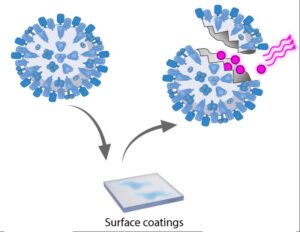Watching viruses fail

Only a few viruses make it to the innermost layer of a fabric mask. The picture shows a textile fiber with salt crystals (light blue) and viruses about 100 nanometers in size (green). (Scanning electron microscopy, colored)
(c) Empa
Using a new analytical method, Empa researchers have tracked viruses as they pass through face masks and compared their failure on the filter layers of different types of masks. The new method should now accelerate the development of surfaces that can kill viruses, the team writes in the journal Scientific Reports.
Using high pressure, the apparatus pushes artificial saliva fluid, colored in red, with test particles through a stretched mask. This is how the researchers simulate the process of a droplet infection. The new method established at Empa is currently used by certified test centers to ensure the quality of textile face masks because a safe and effective protective mask must meet demanding requirements: It must keep out germs, withstand splashing drops of saliva, and at the same time allow air to pass through.

After all, this is precisely one of the goals of the ReMask project, in which research, industry and healthcare experts are teaming up with Empa in the fight against the pandemic to develop new concepts for better, more comfortable and more sustainable face masks.
Dying beauty
The new process relies on a dye, rhodamine R18, which emits colored light. Non-hazardous, inactivated test viruses are used, which are coupled to R18 and thus become dying beauties: They light up as soon as they are damaged. “The fluorescence indicates reliably, quickly and inexpensively when viruses have been killed,” Wick says.
Based on the intensity with which a mask layer glows, the team found that for fabric and hygiene masks, most viruses fail in the mid layer between the inner and outer layers of the mask. In FFP2 masks, the third of six layers glowed the most – again, the central layer trapped a particularly large number of viruses. The researchers recently published their findings in the journal Scientific Reports. These findings can now be used to optimize facial masks.
In addition, the new process can accelerate the development of virus-killing surfaces. “Surfaces with antiviral properties must comply with certain ISO standards, which entail laborious standard tests,” Wick explains. The Empa researchers’ fluorescence method, on the other hand, could be a simpler, faster and more cost-effective way of determining whether a new type of coating can reliably kill viruses, as a supplement to current standards. This would be of interest both for smooth surfaces, such as on worktops or handles, and for coatings on textiles with a porous surface, such as masks or filter systems.
And with the new method, this knowledge could already be integrated into the development process of technical and medical applications at a very early stage. According to Wick, this will speed up the introduction of new products, as only promising candidates will have to undergo the time-consuming and cost-intensive standardization tests.
Wissenschaftliche Ansprechpartner:
Dr. Peter Wick
Particles-Biology Interactions
Tel. +41 58 765 7684
Peter.Wick@empa.ch
Prof. Dr. René Rossi
Biomimetic Membranes and Textiles
Tel. +41 58 765 7765
Rene.Rossi@empa.ch
Originalpublikation:
LA Furer, P Clement, G Herwig, RM Rossi, F Bhoelan, M Amacker, T Stegmann, T Buerki-Thurnherr, P Wick; A Novel Inactivated Virus System (InViS) for a Fast and Inexpensive Assessment of Viral Disintegration; Scientific Reports (2022); DOI: 10.1038/s41598-022-15471-5 https://plus.empa.ch\images\scientificreports-wick-2022.pdf
Weitere Informationen:
https://www.empa.ch/web/s604/antiviral-surfaces Empa media release
Media Contact
All latest news from the category: Materials Sciences
Materials management deals with the research, development, manufacturing and processing of raw and industrial materials. Key aspects here are biological and medical issues, which play an increasingly important role in this field.
innovations-report offers in-depth articles related to the development and application of materials and the structure and properties of new materials.
Newest articles

First-of-its-kind study uses remote sensing to monitor plastic debris in rivers and lakes
Remote sensing creates a cost-effective solution to monitoring plastic pollution. A first-of-its-kind study from researchers at the University of Minnesota Twin Cities shows how remote sensing can help monitor and…

Laser-based artificial neuron mimics nerve cell functions at lightning speed
With a processing speed a billion times faster than nature, chip-based laser neuron could help advance AI tasks such as pattern recognition and sequence prediction. Researchers have developed a laser-based…

Optimising the processing of plastic waste
Just one look in the yellow bin reveals a colourful jumble of different types of plastic. However, the purer and more uniform plastic waste is, the easier it is to…



